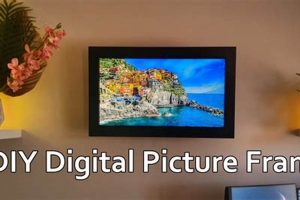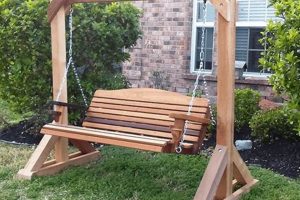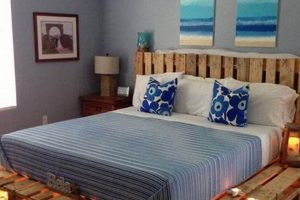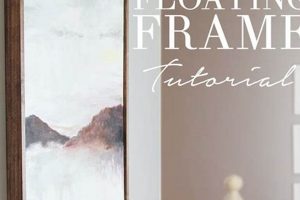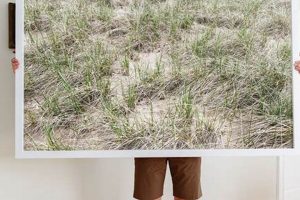A structure designed to support a surface for projecting images, constructed by an individual rather than purchased pre-made, falls under the umbrella of do-it-yourself endeavors. This approach typically involves selecting materials like wood or metal to build a border that firmly holds the screen material, which can range from specialized projection fabrics to more economical alternatives such as blackout cloth. For example, someone might construct a wooden rectangle and stretch a piece of white canvas tightly across it, securing it with staples to create a surface suitable for displaying movies.
Creating a bespoke viewing setup offers multiple advantages. It allows for complete customization of size and dimensions to perfectly fit the intended viewing space. This is particularly useful in situations where standard-sized commercially available options are unsuitable. Furthermore, it often results in considerable cost savings compared to purchasing a professionally manufactured product. The practice of building one’s own viewing setup extends back to the early days of home theaters, reflecting a desire for personalized and affordable entertainment experiences.
The subsequent sections will delve into the essential considerations when undertaking such a project, covering aspects like material selection, construction techniques, and optimal screen surface choices. Guidance on achieving a professional finish and integrating the structure seamlessly into a home theater environment will also be provided.
Tips for Constructing a Projector Screen DIY Frame
The following guidelines are essential for achieving a high-quality, long-lasting, and visually effective viewing platform for projected images. Careful planning and precise execution are paramount.
Tip 1: Material Selection is Crucial. Choose materials based on durability, weight, and aesthetic appeal. Kiln-dried hardwood offers stability and resistance to warping, while aluminum provides a lightweight yet rigid alternative. Consider the environmental conditions of the intended location when making this selection.
Tip 2: Accurate Measurements are Non-Negotiable. Precise dimensions ensure a taut, wrinkle-free screen surface. Double-check all measurements before cutting any materials. A slight deviation can compromise the overall viewing experience.
Tip 3: Employ Proper Fastening Techniques. Use appropriate screws, nails, or adhesives designed for the chosen materials. Corner joints require particular attention; consider using reinforced brackets or dovetail joints for added strength. Inadequate fastening can lead to structural instability.
Tip 4: Tensioning the Screen Fabric Correctly. Achieve uniform tension across the entire surface to prevent distortion. Staple the fabric to the frame in a consistent pattern, working from the center outwards. Specialized screen fabrics often require specific tensioning techniques recommended by the manufacturer.
Tip 5: Consider a Black Border. A black border surrounding the viewing area enhances perceived contrast and reduces distractions. This can be achieved with black velvet tape or paint. The width of the border is a matter of personal preference, but a minimum of 2 inches is generally recommended.
Tip 6: Plan for Mounting Options. Determine the preferred mounting method (wall-mounted, ceiling-mounted, or free-standing) early in the design process. Integrate appropriate mounting hardware into the frame’s structure for secure and stable installation. Failure to adequately address this aspect can result in an unsafe or unusable final product.
Tip 7: Ensure a Flat and Smooth Screen Surface. Imperfections in the frame can translate to visible flaws on the projected image. Sand all frame components thoroughly before attaching the screen material. Consider using a leveling compound to fill any gaps or unevenness.
These tips emphasize the importance of meticulous planning and execution when constructing this kind of viewing setup. Adhering to these guidelines will significantly enhance the viewing experience and ensure the structure’s longevity.
The following sections will provide further guidance on advanced techniques and troubleshooting common issues encountered during the construction process.
1. Frame Material Selection
The selection of materials fundamentally influences the structural integrity, longevity, and overall aesthetic of a do-it-yourself projection surface border. The choice directly impacts the ease of construction, the final weight of the assembly, and its susceptibility to environmental factors such as humidity and temperature fluctuations.
- Wood Species and Grades
The type of wood usedwhether softwood like pine or hardwood like oak or mapleaffects the frame’s resistance to warping and its ability to hold fasteners. Kiln-dried lumber is preferable to minimize post-construction movement. Lower-grade lumber may contain knots or imperfections that compromise structural soundness, while higher grades offer improved dimensional stability and a more refined appearance. An example would be choosing a knot-free pine for a lightweight, paintable border, versus selecting oak for a sturdier, stain-grade appearance.
- Metal Alloys: Aluminum vs. Steel
Metal frames, typically constructed from aluminum or steel, offer distinct advantages in terms of strength and weight. Aluminum provides a lightweight and corrosion-resistant option, suitable for larger screens or portable setups. Steel, while heavier, offers superior rigidity and is better suited for applications requiring extreme stability. The choice depends on the screen’s size and the intended mounting method. A portable screen, for instance, might benefit from an aluminum structure, whereas a large, wall-mounted setup could utilize steel for enhanced support.
- Composite Materials: MDF and PVC
Medium-density fiberboard (MDF) and polyvinyl chloride (PVC) represent alternative material choices. MDF provides a smooth, paintable surface but is susceptible to moisture damage and may sag over time. PVC is water-resistant and lightweight but can be less rigid than wood or metal. These materials are often used in conjunction with other structural elements to reduce cost or weight. A screen built for temporary outdoor use might employ a PVC structure, while MDF could be used for a simple, indoor frame requiring a smooth finish.
- Fabric and Tensioning Systems Integration
The chosen material must also facilitate effective screen fabric attachment and tensioning. Wood allows for stapling or tacking, while metal requires specialized clamping or fastening systems. The frame’s design should account for the necessary tension to prevent wrinkles or sagging. A poorly designed frame may not allow for sufficient tension, leading to a substandard viewing experience. The integration of a fabric tensioning system may necessitate specific frame features, such as channels or grooves, to accommodate the tensioning mechanism.
In summation, the judicious selection of framing materials is paramount in dictating the performance characteristics and longevity of a custom-built projection surface border. Each option presents a unique set of trade-offs, requiring careful consideration of factors such as cost, weight, durability, and aesthetic requirements to achieve the desired outcome. The integration of chosen materials with the screen fabric and tensioning system is similarly critical for achieving optimal image quality and overall viewing enjoyment.
2. Screen Tension Uniformity
Achieving consistent tension across the entire projection surface is paramount for optimal image display within a do-it-yourself viewing setup. Uneven tension directly causes geometric distortions, resulting in visible warping or stretching of the projected image. This effect compromises the viewing experience, diminishing clarity and accuracy. For instance, localized slackness in a corner region may cause text to appear blurred or lines to curve unnaturally. Conversely, excessive tightness in another area could lead to wrinkles or puckering, creating shadows and uneven light distribution. The creation of a custom border provides an opportunity to meticulously control and calibrate the tension during construction, thereby mitigating these potential distortions.
The method of securing the screen material to the structure significantly influences the uniformity of tension. A common technique involves stapling the fabric to the frame, working incrementally from the center outwards. However, this requires careful attention to ensure consistent spacing and pressure with each staple. An alternative approach utilizes a perimeter channel and spring system, which distributes the tension more evenly across the entire surface. Examples of this can be seen in high-end commercial screens, which often incorporate complex mechanisms to maintain a perfectly flat surface. Replicating such systems in a home-built project requires advanced construction skills and a deeper understanding of material properties. A real-world impact of poor tension can be demonstrated when watching a movie with fast-moving objects; if the screen is not uniform, objects will appear to waver or distort as they move across the screen.
Maintaining adequate and consistent tension is not merely an aesthetic concern; it directly affects the perceived resolution and contrast of the projected image. By precisely controlling the tension within the border’s construction, it is possible to mitigate geometric distortions and achieve a viewing surface comparable to that of commercially manufactured products. Challenges arise when dealing with larger screen sizes or less-than-ideal materials, necessitating more sophisticated tensioning techniques. Understanding the principles of tension distribution and their practical application to the construction process is essential for achieving a high-quality viewing experience from a home-built screen.
3. Structural Joint Integrity
Within the context of a do-it-yourself viewing setup border, structural joint integrity constitutes a critical determinant of the assembly’s long-term stability and resistance to deformation. Compromised joints directly impact the planarity of the viewing surface, causing image distortion and premature failure. The following points detail key facets of joint integrity within this application.
- Corner Joint Construction
The integrity of corner joints is paramount. Traditional methods such as butt joints rely solely on fasteners or adhesives, often proving inadequate for larger screens. Mitered joints offer improved aesthetics but still require reinforcement. Advanced techniques, including mortise-and-tenon or dovetail joints, provide superior mechanical strength and resistance to racking. For instance, a screen constructed with simple butt joints may exhibit sagging over time, while one employing dovetail joints is far more likely to maintain its original shape.
- Fastener Selection and Application
The choice of fasteners plays a crucial role. Screws generally provide greater holding power than nails, especially when combined with adhesives. The type and length of screw must be appropriate for the materials being joined. Over-tightening can strip the screw threads, while under-tightening compromises joint strength. Examples include using coarse-threaded screws for joining wood and fine-threaded screws for metal. The application of construction adhesive further enhances joint strength by filling gaps and distributing stress.
- Material Compatibility
The compatibility of materials at the joint is essential. Combining dissimilar materials with differing expansion coefficients can lead to joint failure over time. For example, joining wood and metal without proper isolation can result in stress concentrations due to differential expansion and contraction caused by temperature changes. The use of appropriate adhesives and sealants can mitigate these effects. This is particularly relevant in environments with significant temperature fluctuations.
- Reinforcement Strategies
Employing reinforcement strategies enhances joint integrity. Metal brackets, corner braces, or gussets can significantly increase the strength and stability of joints, particularly in larger structures. These reinforcements distribute stress and prevent joint deformation. An example includes using corner braces on a large, free-standing screen to prevent wobbling or collapse. The selection of reinforcement methods should be based on the anticipated load and environmental conditions.
These facets underscore the critical relationship between structural joint integrity and the overall performance of a do-it-yourself projection screen border. Properly designed and executed joints are essential for maintaining the screen’s planarity, preventing image distortion, and ensuring long-term stability.
4. Optimal Aspect Ratio
The aspect ratio, defined as the proportional relationship between an image’s width and height, presents a foundational consideration in the creation of a viewing setup. The selection of an appropriate aspect ratio for the structural components directly impacts the viewing experience, dictating how content is displayed and whether letterboxing or stretching occurs. Constructing a border that does not align with the primary content’s aspect ratio results in suboptimal viewing. For instance, a frame designed for a 4:3 aspect ratio will display widescreen (16:9) films with significant black bars at the top and bottom, diminishing the immersive quality of the presentation. Therefore, determining the dominant content format precedes the construction process. A common practice involves selecting a 16:9 ratio, the standard for modern television and many films, to maximize versatility. However, enthusiasts primarily viewing cinemascope films (2.35:1) might opt for that wider format.
Integrating the optimal aspect ratio directly into the building process involves precise dimensional calculations. After deciding on the preferred ratio, the user must determine the desired screen size based on viewing distance and room dimensions. These factors then dictate the precise width and height measurements for the border. It is crucial to account for the width of the border material itself when calculating the overall dimensions to maintain the correct viewing area. Failing to do so results in a viewing area that is either smaller or larger than intended, thereby compromising the carefully chosen aspect ratio. Advanced users might also consider incorporating masking systems into the design, allowing for on-the-fly adjustment of the visible area to accommodate different aspect ratios, thereby mitigating the need for multiple screens. This can be achieved with manually adjustable panels made of black velvet, which absorb excess light and create a sharp, defined edge.
In summary, selecting the proper aspect ratio and integrating it into the construction process are pivotal for ensuring an optimal viewing experience. This choice impacts the immersion, clarity, and overall enjoyment of the displayed content. While seemingly straightforward, the consequences of neglecting this factor extend beyond mere aesthetics, affecting the perceived quality of the projected image and potentially negating the benefits of a custom-built system. Prioritizing aspect ratio alignment during the planning stages allows for a tailored viewing environment, optimized for the user’s preferred content and viewing habits.
5. Ambient Light Rejection
Ambient light rejection constitutes a critical performance parameter for viewing setups, particularly within the context of a customized construction. The capacity of the screen to mitigate the adverse effects of extraneous light directly impacts perceived image contrast, color saturation, and overall viewing clarity. In situations where complete light control is not feasible, strategic incorporation of ambient light rejection techniques becomes essential for achieving a satisfactory viewing experience.
- Screen Material Selection
The primary method of enhancing ambient light rejection lies in the selection of specialized screen materials. These materials typically incorporate optical coatings or structured surfaces designed to preferentially reflect light from the projector while diffusing or absorbing ambient light from other sources. For instance, certain screen fabrics utilize a micro-layered structure to direct projected light towards the viewer while rejecting off-axis light from windows or lamps. In the context of a custom-built viewing setup, the choice of fabric is paramount, influencing the perceived image quality far more than other construction factors. Selecting a high-gain ALR (Ambient Light Rejecting) screen material would have greater cost but offer an improved viewing experience.
- Border and Room Color Optimization
The color and reflectivity of the surrounding environment exert a substantial influence on perceived contrast. Light reflected from walls, ceilings, and other surfaces can degrade image quality, washing out colors and reducing black levels. Incorporating a dark border around the viewing area and employing darker wall colors minimizes unwanted reflections. A black velvet border, for example, absorbs stray light, creating a more defined edge and enhancing the perceived contrast ratio. When constructing a customized screen, the integration of a black border is a relatively simple yet highly effective measure for improving ambient light rejection.
- Projector Placement and Angle
The placement of the projector relative to the screen and ambient light sources plays a crucial role in optimizing image quality. Angling the projector to minimize direct light from windows or lamps reduces the amount of ambient light hitting the screen surface. Using a short-throw projector can help to reduce shadows and minimize the impact of ambient light. Careful positioning, in combination with ambient light rejecting screen material, significantly enhances contrast and color saturation, especially in uncontrolled lighting environments.
- Optical Coatings and Filters
Applying optical coatings or filters to the projector lens or screen surface represents another method of enhancing ambient light rejection. These coatings can selectively filter out specific wavelengths of light, improving color accuracy and contrast. While less common in do-it-yourself projects, these techniques offer a potential avenue for further optimizing image quality. An example is the use of a neutral density filter on the projector lens to reduce the overall brightness, allowing for improved contrast in bright conditions.
The integration of ambient light rejection strategies into the construction process extends beyond mere aesthetics, directly influencing the perceived clarity, contrast, and color accuracy of the displayed image. The selection of specialized screen materials, optimization of the viewing environment, and strategic positioning of the projector contribute to a viewing experience that is more resistant to the deleterious effects of uncontrolled lighting conditions. It becomes clear that careful consideration of the ambient light environment is paramount to get the best experience.
Frequently Asked Questions
The following questions address common concerns and misconceptions regarding the construction and optimization of do-it-yourself viewing setups.
Question 1: What is the most cost-effective material for a basic structure?
Untreated pine lumber represents a frequently used, relatively inexpensive option. Ensure the lumber is straight and free from significant knots to minimize warping. MDF (Medium Density Fiberboard) provides a smooth surface but is susceptible to moisture damage. Cost analysis must consider material lifespan.
Question 2: How can accurate screen tension be achieved without specialized tools?
A consistent stapling pattern, starting from the center and working outwards towards the edges, assists in evenly distributing tension. Applying gentle, uniform pressure while stapling prevents wrinkles or sagging. Monitor tension and make adjustments as you go. Take your time and make many small corrections.
Question 3: What are the essential tools required for constructing a border?
A circular saw or miter saw is vital for accurate cuts. A power drill or screwdriver is necessary for fastening materials. A staple gun secures the screen material. A measuring tape and level ensure dimensional accuracy and a flat viewing surface. Safety glasses are also required.
Question 4: How is light bleed behind the screen minimized?
Applying a layer of opaque material to the back of the screen fabric blocks light transmission. Blackout cloth or dark-colored paint are effective solutions. Ensure complete coverage to prevent any light leakage. A dark paint will also help reduce reflection if there’s light behind the screen.
Question 5: What is the ideal viewing distance relative to screen size?
A generally accepted guideline suggests a viewing distance of approximately 1.5 to 2.5 times the screen width. This range provides an immersive experience without causing eye strain. Adjustments based on personal preference and visual acuity are recommended.
Question 6: How can the visual impact of wrinkles or imperfections on the screen be mitigated?
Applying gentle heat from a hairdryer or iron (on a low setting and with a protective cloth) can sometimes reduce minor wrinkles. Ensure the screen material is securely fastened and properly tensioned. If wrinkles are severe, replacing the material may be necessary.
The construction of a cost-effective and high-performing viewing setup hinges on meticulous planning, precise execution, and a thorough understanding of materials and techniques.
Subsequent sections will provide detailed instructions on specific construction methods and advanced optimization techniques.
Conclusion
The preceding sections have explored the multifaceted considerations involved in the creation of a bespoke viewing platform. Material selection, tensioning techniques, joint integrity, aspect ratio optimization, and ambient light rejection strategies were all examined. These elements are crucial for achieving a high-quality viewing experience that rivals professionally manufactured products.
Effective implementation of these principles necessitates careful planning and meticulous execution. While the construction of a viewing setup presents a cost-effective alternative to commercial offerings, it also requires a commitment to precision and a thorough understanding of relevant construction techniques. It should be approached with diligence and careful planning.


